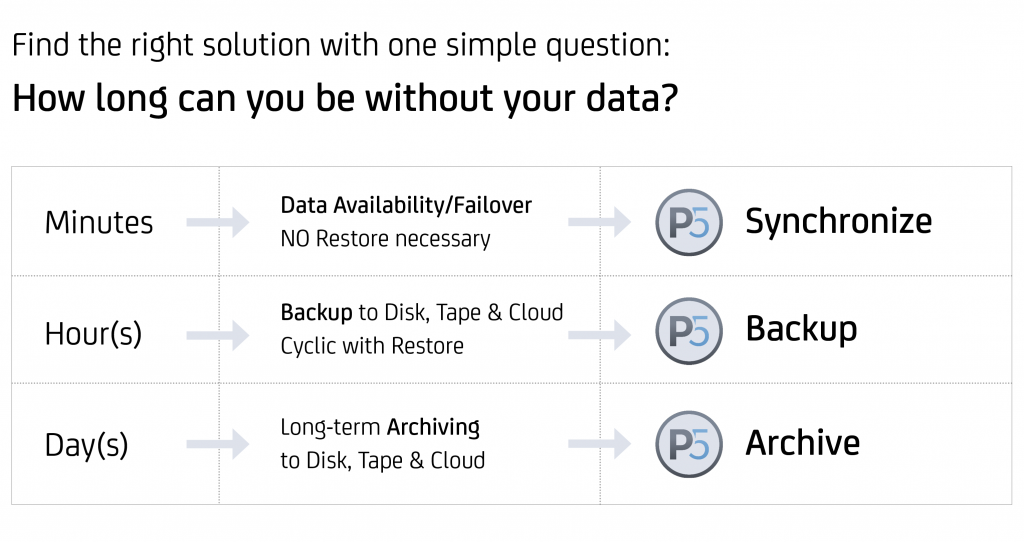When Files Are Placed on a Server
Past Dr. Marc K. Batschkus

Whenever multiple users need the same cadre set up of files, a file server backup has its place.
File servers can range from small to very big, from single TBs to PB data sets. Today, there are very simple-to-utilize file servers that are non even called the latter, like NAS systems. Since their use is so widespread, they are an important focus for Fill-in to protect the data residing on them.
To get an idea how much you should invest in your data protection, think from the terminate. What would happen if your information becomes inaccessible? How would that touch your business? How much time do y'all have to get the data back or what would information technology cost to copy the information (if at all possible)?
This gives yous an idea of the real value of your business data and the corporeality to invest to protect it.
When should you backup your file server?
A file server, or any shared storage that multiple users work on, deserves a Backup.
The respond depends on how important the data is and what tolerance for possible data loss exists. The interval betwixt Fill-in runs represents the time bridge of maximal data loss that tin can occur. A daily Backup ways that the maximum amount of information that can exist lost is data that has been produced or inverse during 1 day.
Let'southward take a closer look at some best practices that help to create a thorough Backup solution.
All-time practice #1
The most important step is to automate Backup. Any transmission process is subject to errors and will be left out when the fourth dimension pressure increases. The automatic run of the Backup should avoid heavy load periods of the network and servers.
Best practice #2
Use the three-2-1- rule and create three copies of each file on two different media (SSD/disk or disk/tape or disk/cloud) and 1 of them kept offsite.
Best do #3
Segment your data. Some data might be actually time critical, while other data is less urgent to restore in case something happens. Some data might even be put away in an annal to save space on product storage.
Each of these categories demand their ain data protection solution. Fourth dimension disquisitional information needs immediate access with no restore process. Data availability or cloning is the way to go here. Archiware P5 Synchronize replicates disk, RAID, SAN and NAS storage either locally or via WAN to another location.
Less time critical data tin can be secured using a regular Backup to disk, tape or deject storage. The necessary restore has a runtime that grows with the number and size of the files being restored.
Data that is no longer needed for daily production should drift to an Archive. This saves infinite and cost and reduces the number of files on the production storage. P5 Annal can write to deejay, tape or cloud and offers a catalog for browsing and searching all archived files including optional metadata.

All-time practice #4
Do your calculations. A file server Backup needs some planning. As already mentioned, the interval between Fill-in runs equals the maximum amount of data that tin be lost if something goes incorrect. This is called the Recovery Bespeak Objective or RPO.
Of course, a Backup tin also run several times during the mean solar day or—if data availability is needed—even every couple of minutes. This has consequences for the functioning of the network, the load on the server and the storage needed. All of these have to be specified accordingly.
There is one more than important tolerance to consider: the time to recover all data in case of an emergency. This reflects the tolerance for interruption of business continuity. Depending on the size of the data set, recovering all files from a Backup can take hours, days or fifty-fifty weeks. The choice for the Backup process and Fill-in storage needs to take into account this tolerance (or the lack of information technology). The time needed to get all data back is called Recovery Fourth dimension Objective or RTO.
Best practise #five
Create an off-site backup. If something happens that impacts the principal location, chances are the Backup is affected as well. Just an off-site copy is a valid disaster recovery. This can as well be a Backup to the cloud. As an example, P5 Backup works with record and deject storage and both tin can be used for an off-site backup.

Best exercise #6
Use air gap storage for maximum security. With today's threats and permanent online connections, whatever storage tin can be affected very rapidly.
To prevent this, a Backup or one of the Backups needs a physical gap between the network and the Backup storage. Using hard disks for this is possible, merely might not be reliable over the long-term. Also, equally soon equally they are connected, they become "hot" storage and can exist infected as well.
There is merely ane medium that has a built-in air gap and that is record. Whatever tape that is not mounted in the tape drive is physically separated from the network. Fifty-fifty the tape that is in the bulldoze in save, since in that location has been no known attack on record drives.
Best practise #7
Regularly bank check log files and reports. The best solution only works also every bit it is monitored and maintained. Small things that go wrong might add together upwardly. Storage might make full or the name of a directory might be inverse. There are many reasons why a Fill-in might not work completely. It is best to accept a person who is in accuse and regularly checks log files and receives the reports of the Backup system.
All-time practice #8
Document the restore process step-by-step. Information technology is important to have a thorough and up-to-date documentation for anyone performing the restore when something goes wrong and a recovery is necessary. The ane who configured the Backup might not be nowadays at that time.
All-time practice #ix
Have a specific Fill-in solution for your NAS. Since NAS devices are mostly used to store shared data, the value of the data is considerable. If something goes incorrect, several people might not be able to go along with their piece of work. For this reason, it makes sense to back up the NAS. A specific Backup solution tin can run on the NAS itself and tin can therefore exist more than efficient. QNAP, as well as Synology and Netgear accept their respective App Centers to detect and install native apps on the NAS itself. The Archiware P5 suite is available in all three App Centers. P5 Fill-in offers all features necessary to protect a NAS.
All-time practice #ten
Take a specific Backup solution for virtualised servers (like VMware). A snapshot is not a Backup, since information technology relies on the complete setup to piece of work. If something goes wrong, a snapshot might non give you whatsoever data back that you demand. Therefore, a real Fill-in requires data to be secured to another storage. A robust Backup solution for VMware is Archiware Pure (and it is complimentary).

Best practice #11
Exam the restore procedure regularly. With a file server Backup, you demand to make sure that the consummate chain of devices and connections works every bit expected. The all-time practise is to practice this every month. This ensures that the restore works when it is really needed.
Having a Backup of all business-relevant information gives peace of listen and a sense of security in case something happens. If planned and implemented correct, information technology runs on its own and provides upwards-to-date copies of all files.
Archiware P5 offers restore access via the browser and the option that everyone in a company can restore their own files. This takes load off the ambassador and avoids interruptions because of single lost files.
Source: https://blog.archiware.com/blog/file-server-backup/
0 Response to "When Files Are Placed on a Server"
Post a Comment